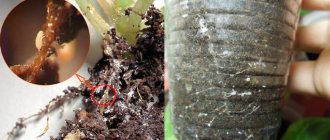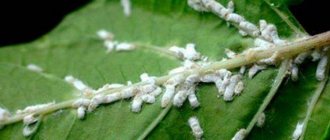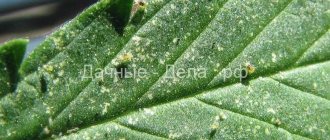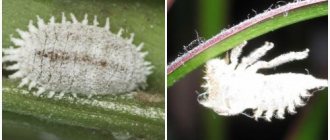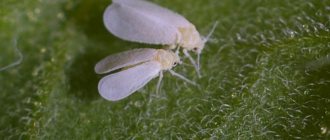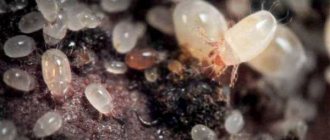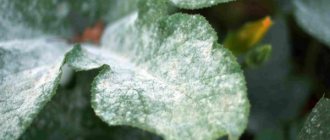Pests How to deal with scale insects on indoor plants Scale insects are dangerous insect pests that attack indoor plants. Most often they accumulate on the leaves, stems and petioles of flowers, with their entire body tightly adjacent to their surface. In a few days, insects can spread to all the plants in the apartment and destroy them, so the appearance of at least one pest is a reason to immediately begin the fight. You can get rid of scale insects using modern insecticides or folk remedies.
Features of scale insects
Scale insects can settle on both garden and indoor crops and cause serious harm to them. The body of the pest is covered with a high-density protective shell, which includes 1-2 skins, as well as secretory wax. The shield can be easily detached from the body. The pest has a sucking mouthpart. Different species differ in size, color and taste preferences.
This pest is dangerous because immediately after the larvae emerge from the eggs, they spread throughout all above-ground parts of the plant. At the same time, they begin to actively suck out cell sap. It often happens that pests cover the entire surface of the leaves.
Larvae can be found on the stem, trunk and underside of leaf blades. If there are a lot of pests, then a coating consisting of their bodies appears on the bush. Because of this, the leaf plates turn yellow and die ahead of time, the stems dry out, and the plant itself stops developing and growing.
Adults and their larvae can be found on domestic plants all year round. Their reproduction occurs rapidly. Most species of scale insects reproduce by oviparity, but viviparous species are also found. At first, the larvae are highly mobile. At the same time, flying males are the most mobile, so they easily move to nearby bushes. But the lifespan of males is only a few days. Females live for several months and actively reproduce during this time.
Pests secrete honeydew during their life, which is a sticky coating. A sooty fungus settles on it, which also harms the plant.
There are also false scale insects, which are easily confused with scale insects. These are arthropod insects that are part of the same order. However, they are classified into a separate family, which consists of more than 1000 species. False scale insects differ from scale insects in that they lack a waxy shell. The dried skin of females, which die after laying eggs, acts as protection for oviposition and larvae.
How to understand that scale insects have settled on a bush? Young individuals move quite quickly, and they can only be seen with a magnifying glass. If, at the junction of the leaf cuttings and the shoot or trunk, there are rounded scales of brown or light color, then this means a scale infestation. Moreover, the scales are adults. If there are already a lot of insects on the plant, then honeydew (sticky liquid) will begin to drip from it onto the windowsill, which is also a clear sign of the presence of scale insects.
Plant pests. Saving phalaenopsis. Scale insect: what it looks like, where it hides, how to get rid of it.
Signs of defeat
You can determine that scale insects have settled on a flower by the following signs:
- The plant's young shoots begin to wither and soon stop developing altogether.
- A sticky liquid appears on the green mass.
- The leaf blades turn yellow, wither and crumble.
- The general condition of the plant deteriorates, it weakens.
- Flower buds become deformed and change color.
- The stem gradually becomes dead.
Important . With a strong scale infestation, all parts of the plant die.
Preventative treatment
In order to protect your home plants from scale insects, you will need to take a number of preventive measures:
- You need to regularly check the quality of the substrate in the container with the plant. Pay attention to how clean and high quality it is.
- Trim weakened and dead stems in a timely manner, and the cut areas should be disinfected.
- Be sure to regularly ventilate the room in the last winter and first spring weeks. Make sure the humidity level is appropriate for the plants. If necessary, systematically moisten them with a sprayer, especially the underside of the foliage.
- Any new bush must be quarantined for 4 weeks. It is also needed by those crops that were outside in the summer. They are placed separately from other house plants and observed for some time. You can also treat plants to prevent pests and diseases.
Prevention measures
It is better to prevent a disease than to cure it
Therefore, flower growers should pay attention to the timeliness of carrying out preventive measures against scale insects. They consist of five steps:
- Introduction of quarantine. This applies to newly purchased plants. They are initially placed in a separate room and preventively sprayed with insecticides and fungicides.
- Carrying out systematic monthly treatments with soapy water.
- Regular pruning of plants. As soon as yellowed and wilted leaves appear, they must be removed. Under no circumstances should fallen leaves be left in the pot - they must be removed.
The best protection of indoor flowers from scale insects preventive measures
- Carrying out disinfection measures in the form of treating the plant with a weak solution of potassium permanganate.
- Ensuring proper care of indoor flowers. Eliminating the crowding of flowering plants on the windowsill and maintaining temperature and humidity levels will help minimize the likelihood of scale insects appearing.
These insects love hot and stuffy rooms. Therefore, you need to try to systematically ventilate the room, but not create drafts. And in the summer, place flowers on the balcony, providing access to fresh air. This process is called hardening of specimens by flower growers.
As you can see, it is difficult to get rid of scale insects during mass infestation. Therefore, it is necessary to take all measures to prevent the occurrence of pests. If the plants are carefully inspected and treated regularly, then your favorite flowers will not be at risk of infection. They will be able to delight with their beauty for a long time.
How to get rid of scale insects
Fighting methods
How to deal with scale insects indoors? This can be done in various ways. If there are few pests on the bush, then you can give it a warm shower (45 degrees), and then the remaining adult pests should be removed mechanically with a cotton swab moistened with alcohol or an unnecessary toothbrush.
It is necessary to re-inspect the plant after a week and a half. If you find scale insects again, they need to be removed mechanically, and then treated with any folk remedy. A follow-up examination is carried out after 2 weeks.
If pests were initially found on several bushes, it is recommended to treat them with a folk remedy. If there are a lot of pests, then you should spray with a pesticide.
Folk remedies
There are many folk remedies used to kill scale insects. They act more gently than pesticides, but are also less effective. As a rule, they are used for preventive treatments, as well as for spraying plants at the initial stage of infection.
Folk remedies:
- Remove pests from leaf blades using a toothbrush. Then the injured areas should be smeared with onion, crushed to a mushy state. After this, treatment is carried out with a mixture consisting of one liter of water and 25 grams of green soap (40 grams of laundry soap), which is pre-ground on a grater. Literally five drops of kerosene are added to the finished mixture and everything needs to be mixed well again. Treat the shoots and foliage with a spray bottle with the prepared product, or you can lubricate them.
- When the plant is mechanically cleaned, it is treated with an oil-soap mixture. To prepare it in 1 tbsp. of water, beat 5 to 10 grams of any soap product (dishwashing detergent, grated soap, washing powder or flea shampoo) until foam appears. Then 20 to 30 mg of technical oil is poured into the mixture. The surface of the substrate in the container is covered with plastic film to protect it from the mixture. Treat shoots and foliage. Wash the bush well with cold water after 6–12 hours. To get rid of the pest completely, you need to treat the plant with this composition 2 or 3 times with a break of 1–1.5 weeks.
- In 1 tbsp. add five garlic cloves to the water, which must first be chopped. Cover the container tightly and put it in a dark place. After a few hours, filter the mixture using gauze folded in three layers. Spray the bush with the infusion, which must first be mechanically cleared of pests. It is necessary to treat the plant 3 or 4 times. In the same way you can make an infusion of onions: for 1 tbsp. water 1 medium sized onion.
- Pepper infusion is very effective and can be stored for a long time. For every 100 milligrams of water, take 10 grams of finely chopped fresh hot pepper. It should be boiled for five minutes. Bring the mixture to the original volume by adding the required amount of water. Cover the container tightly and leave for 24 hours. Then the broth is filtered and placed in a sealed container. Store on the refrigerator shelf.
- Dried celandine herb in an amount of 0.3 kg is mixed with a liter of hot water. Cover the container tightly and leave the mixture for 24 hours. Filter the infusion and treat the bush with a spray bottle or wipe the shoots and foliage with it.
- Combine half a liter of water and 1 tbsp. l. olive oils. Using a brush, this composition is distributed over the surface of the plant. Insects die because oxygen ceases to flow to them. The procedure is carried out once every 7 days until the pests are completely killed. Olive oil can be replaced with transformer oil (4 milligrams per 1 liter of water).
- 0.5 liters of water are mixed with 40 grams of dried tobacco leaves. The infusion is kept for 24 hours, after which it is filtered and diluted with water 1:2.
Insect pests Scale insects on indoor flowers. Website "Garden World"
Remedies and preparations for scale insects
If there are already a lot of pests, then it is recommended to treat the bush with an insecticidal preparation as soon as possible:
- Bankol . Differs in contact-intestinal action. It paralyzes insects, causing them to die 72 hours after treatment. The product has low toxicity for humans.
- Fitoverm . This highly effective drug has low toxicity for humans. But to get rid of the pest, the flower needs to be treated several times.
- Mospilan . Systemic insecticidal drug. It penetrates the plant tissue, causing the death of larvae, adults, and eggs.
- Aktara . Systemic highly toxic agent. Recommended for use in open ground, but you must adhere to safety precautions.
- Phosbecide . Insectoacaricide of systemic and intestinal action, characterized by toxicity. When working with it, you must take precautions.
- Ragor (BI-58) . Insectoacaricide of contact-intestinal action, characterized by high toxicity and a pronounced, unpleasant odor. It is also recommended to use it in open ground, but do not forget about precautions.
- Aktellik . Insectoacaricide with a wide spectrum of action. Does not contribute to the development of addiction in pests, and also prevents their reappearance.
- Bitoxibacillin . Bacterial insecticidal preparation. Promotes intestinal damage in scale insects. After 24 hours of spraying with the product, the pests stop eating, which leads to their death after 3 days.
In addition to the listed means, the following are used to exterminate such a pest: Konfidor, Iskra Zolotaya, Fufanon, Novaktion, Alatar, Tanrek, Colorado, Karbofos, Kemifos, Antiklesch, Admiral, etc.
Scale insects on plants ❦ my simple way to combat scale insects ❦ helped the first time
How to deal with scale insects on indoor plants
Most often, scale insects settle on indoor crops such as tropical and subtropical palms, cacti, indoor roses, citrus fruits, begonias and pomegranates. They also like to settle on ferns and representatives of the Araceae family, for example: caladium, philodendron, monstera, calla and spathiphyllum.
Scale on an orchid
Also, the scale insect often settles on a lovely orchid. It is especially a pity for the gardener to lose this plant, because it is not only very beautiful, but also costs a lot of money. How to save an orchid from scale insects? In this case, it is not recommended to use pesticides, but the final choice of product is influenced by the degree of damage to the flower.
After detecting insects, you need to rinse the bush as quickly as possible under a warm shower, while trying to remove all pests from its flower stalks and foliage, using an unnecessary toothbrush. Next, place the flower in quarantine, and you can put it in a greenhouse: such pests do not like high humidity. Instead, you can put a transparent plastic bag on the bush, which must be removed twice a day for a third of an hour to ventilate the bush and to prevent burns.
Next, the orchid needs to be treated with either a pesticide or a folk remedy. Of the chemical products, gardeners most often use Fitoverm, Aktar and Aktellik. At the same time, among the folk remedies most often used to treat such an exotic plant are onion, pepper or garlic infusions, as well as soap and kerosene emulsion. You can also treat the bush with alcohol. For species with thick foliage, the bush must be treated with a cotton pad, which is moistened in ethyl alcohol. Varieties with thin leaves are treated with an ethanol solution (10 ml per 1 liter of water), and a brush is used to apply it.
so that the ORCHID DOES NOT SUCK THE JUICE, scale insects on the orchid are easy to get rid of!
Scale insect on lemon
Pests can get on indoor lemons from fruits, other indoor crops, or from bouquets of fresh flowers. Also, the pest may end up in the room, getting there through the window with a gust of wind. Remember that the optimal level of air humidity in the room is an effective preventive measure against scale insects.
If pests settle on a lemon, then its growth will deteriorate and the foliage will begin to yellow and become smaller. If you have symptoms, you need to act immediately. First, try to remove all pests from the plant with a toothbrush, after which it is washed well under a warm shower. Then wipe all leaf blades and the trunk with a cotton pad moistened with alcohol. Finally, spray the bush with an insecticidal solution. Repeated spraying must be done after a week and a half.
If there are not very many insects on the tree, then the treatment can be carried out with a folk remedy: onion infusion, kerosene-soap emulsion or a solution of transformer (olive) oil.
Whenever you treat a bush, be sure to protect the surface of the substrate in the pot with film. And after you get rid of the scale insects completely, it will not be a bad idea to replace the top layer of the substrate in the container.
The simplest method of treating lemon scale insects!!! Diaspididae treatment.
Scale insect on ficus
Pests get to your home ficus in the same ways as they do to lemons. The initial symptom of the appearance of scale insects is considered to be a sticky coating on the foliage, which is honeydew (honeydew). Sooty fungus settles on it quite quickly.
Carefully inspect the branches, trunk and underside of the leaf blades. On them you can see adult individuals, which are plaques of a brownish-gray or whitish hue. Over time, the surface of the leaf plates becomes unsightly and uneven due to the growth of new tissue. The foliage turns red, becomes deformed and dies. If no measures are taken, then after a couple of years mass death of branches and foliage will begin, and cracks will appear on the bark. Most often, the pest settles on the Benjamin ficus.
How to help ficus? Cut out any branches and foliage that are particularly affected. Next, give the bush a warm shower and, using a stiff sponge or brush, thoroughly clean all its above-ground organs from pests. If there are few pests, then a biological or folk remedy can be used for treatment. However, experienced gardeners advise moving the bush outside and spraying it with a powerful insectoacaricide.
But even this will not give a 100% guarantee of complete destruction of pests. Therefore, after three or four days, a control examination is carried out. If you find scale insects again, then wash the bush again and remove the insects with a brush. After 7 days, treat the bush again with a pesticide. Next, do not forget to regularly inspect your ficus.
Scale insect on ficus benjamina. Cat flea drops against scale insects. How to replace Aktara
How to get rid of scale insects in the garden
Scale insects can settle not only on house plants, but also in the garden. At the same time, it is quite difficult to get rid of them. As a rule, pests appear on the site along with new planting material. But there are other methods of infecting garden crops with scale insects.
Quite often, such an insect settles on gooseberries and currants. The hatching of larvae is observed during the flowering period of the bush, after which they quickly attach themselves to the branches, stems and foliage. You can get rid of larvae quite simply and quickly using chemicals. However, adults have a chitinous shell and a waxy layer, which provide powerful protection. Most chemicals simply cannot overcome this protection. Therefore, the plant is cleaned of adult insects using a stiff plastic or metal brush. Trim and destroy all shoots and foliage that contain many scale insects.
In this case, it is much easier to prevent the appearance of pests than to get rid of them. Therefore, it is recommended to regularly carry out preventive treatments with folk and chemical remedies. Treat shrubs and the soil surface underneath them with Nitrafen solution (3%). This is done before sap flow begins in early spring. This will help destroy all the larvae that were hiding from winter frosts in the bark of branches and in the top layer of soil.
Another effective way is to wipe all the branches of the bush with a soft cloth dipped in kerosene-soap emulsion. However, this procedure must be carried out systematically and quite often.
This pest can also settle on fruit trees and ornamental crops. But no matter what plant in the garden it settles on, you need to fight it using the same methods as on currants.
Alexander Petrov. Treatment for apple scale insects and acacia false scale insects
Types of scale insects with photos and names
Scientists have found a very large number of species of scale insects. At the same time, they differ from each other in food preferences. For example, the yellow pear scale insect can settle on cherries, pears, plums, hornbeams, sweet cherries, apple trees, peach trees and ash trees, as well as hawthorns and privets. At the same time, the red pear scale insect, in addition to pome and stone fruit trees, prefers horse chestnut, walnut and dogwood.
On fruit trees, as a rule, comma-shaped, violet, rose-colored scale insects, as well as red and yellow pear scale insects live. Poplar, euonymus, willow and rose scale insects, as well as pine, spruce and fir, can settle on ornamental shrubs and trees.
Mulberry scale is found in the garden. It feeds on pumpkins, fodder beets, eggplants and carrots, and can also harm ornamental and fruit bushes and trees. Household crops can be affected by ivy, orange comma, cactus, palm and euonymus scales. Below is a description of those species that are most widespread and pose the greatest danger:
California scale insect (Quadraspidiotus perniciosus)
This species is very dangerous for plants in the garden. It can settle on plants such as lilac, quince, cherry, plum, apple, rose, apricot, cherry, peach, pear, hawthorn, etc. This pest has a miniature size and a dark gray color. In an adult female, the length of the scutum does not exceed 0.15–0.2 cm. The homeland of this species is Northern China and Primorye. However, today it is found in every corner of the world. This insect differs from other pests in that it leads to very rapid destruction of the vascular system of the bush. If it settles on a pome crop, then concentric red spots appear on its fruits.
False Californian scale insect (Quadraspidiotus ostreaeformis)
Settles on willow, linden, hawthorn, yellow acacia and fruit trees. The short oval or rounded scutellum of the female is colored orange or yellow, its size is approximately 0.2 cm. The edge of the scutum is olive-gray or brown.
Mulberry scale (Pseudaulacaspis pentagona)
It is a polyphagous insect, like the Californian scale insect. It settles on bushes and fruit trees, as well as on vegetable plants. The female's body is colored yellow or pale orange, and its size is about 0.2 cm.
Comma scale insect (Lepidosaphes ulmi)
It has become widespread in mid-latitudes. This species lives on pear, hawthorn, rowan, apple, plum and currant trees. In the female, the brownish-gray scutellum has a curved, comma-shaped shape. Its size is about 0.3 cm, and both the female herself and her egg hide under it. The larvae are colored yellow.
Cactus scale (Diaspis echinocacti)
It harms both cacti and other succulent plants. The pest quickly “captures” the entire bush. The white shield is round in shape and measures about 0.25 cm.
Rose scale insect (Aulacaspis rosae)
She prefers to settle on roses, rose hips, strawberries and blackberries. Its vital activity leads to rapid and significant destruction of the vascular system of the bush. The pest itself is yellow or brown and covered with a white shield about 0.4 cm in size.
In addition to the listed varieties, at home and in the open ground you can find such varieties as European pear, brown, thuja, apple comma, orange comma, red orange, pine spindle and thorn scale.
We destroy scale insects on indoor flowers!
Causes of appearance and damage caused
The danger of scale insects is indicated by the following fact:
In the event of a massive attack of this insect on open ground crops in the region, a quarantine may be declared, including a ban on the export of plants and their parts. Under favorable conditions, it easily spreads to neighboring plants.
Therefore, read where it can appear in your indoor plant kingdom and take protective measures.
In the vast majority of cases, scale insects come to houseplants from other green plants purchased from collectors or nurseries.
Less often, it moves from plants in the open ground to indoor flowers that have been taken outside. Or from branches, fruits and leaves of infected specimens.
In very rare cases, pest larvae can be carried through the air onto flowers standing on the balcony.
Information Scale insects are a prolific and dangerous pest. If the plant is left untreated for a long time, then she may fall in love with it completely, and it will only take her 3-4 years to destroy a large tree!
The scale insect is dangerous because it gnaws holes in the leaves and stems through which it sucks out the juices of the plant. It quickly becomes depleted, lacking nutrients, and slowly dies.
You can prevent the appearance of scale insects by following a few simple rules:
- carefully inspect all purchased indoor plants for pests;
- keep new specimens for a week on a separate windowsill before moving them to the rest of the collection;
- take good care of your green pets, as healthy plants have some natural immunity against pests;
- cut off dried and damaged leaves and branches;
- Rinse plants in the shower after moving them from the open air into the house.


